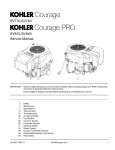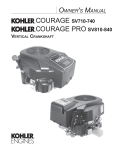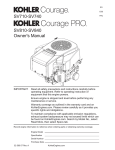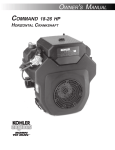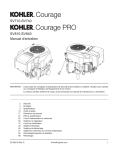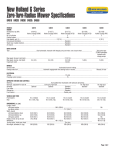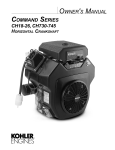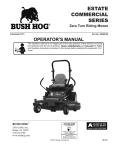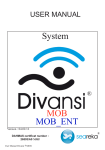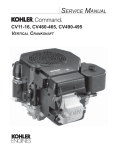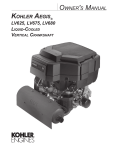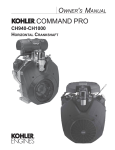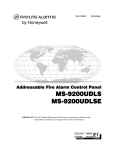Download Operating instructions KOHLER SV720
Transcript
You can read the recommendations in the user guide, the technical guide or the installation guide for KOHLER SV720. You'll find the answers to all your questions on the KOHLER SV720 in the user manual (information, specifications, safety advice, size, accessories, etc.). Detailed instructions for use are in the User's Guide. User manual KOHLER SV720 User guide KOHLER SV720 Operating instructions KOHLER SV720 Instructions for use KOHLER SV720 Instruction manual KOHLER SV720 You're reading an excerpt. Click here to read official KOHLER SV720 user guide http://yourpdfguides.com/dref/3373928 Manual abstract: .......... ..... ..... .......... .......... ..... ..... .......... .......... .. Section 5. Fuel System and Governor.. ..... .......... .......... ..... ..... .......... .......... ..... ..... .......... ........ Section 6. Lubrication System . ..... ..... .......... .......... ..... ..... .......... .......... ..... ..... .......... .......... ..... . Section 7. Electrical System and Components ... .......... .......... ..... ..... .......... .......... ..... ..... ....... Section 8. Disassembly.. .......... ..... ..... .......... .......... ..... ..... .......... .......... ..... ..... .......... .......... ..... .. Section 9. Inspection and Reconditioning .. .......... .......... ..... ..... .......... .......... ..... ..... .......... ...... Section 10. Reassembly... ..... ..... .......... .......... ..... ..... .......... .......... ..... ..... .......... .......... ..... ..... ..... Section 11. Emission Compliance Systems.... .......... ..... ..... .......... .......... ..... ..... .......... .......... .. Section 1 Safety and General Information Section 1 Safety and General Information Safety Precautions To ensure safe operation please read the following statements and understand their meaning. Also refer to your equipment manufacturer's manual for other important safety information. This manual contains safety precautions which are explained below. Please read carefully. WARNING Warning is used to indicate the presence of a hazard that can cause severe personal injury, death, or substantial property damage if the warning is ignored. CAUTION Caution is used to indicate the presence of a hazard that will or can cause minor personal injury or property damage if the caution is ignored. NOTE Note is used to notify people of installation, operation, or maintenance information that is important but not hazardrelated. For Your Safety! These precautions should be followed at all times. Failure to follow these precautions could result in injury to yourself and others. 1 WARNING WARNING WARNING Accidental Starts can cause severe injury or death. Disconnect and ground spark plug leads before servicing. Rotating Parts can cause severe injury. Stay away while engine is in operation. Hot Parts can cause severe burns. Do not touch engine while operating Accidental Starts! Disabling engine. Accidental starting can cause severe injury or death. Before working on the engine or equipment, disable the engine as follows: 1) Disconnect the spark plug lead(s). 2) Disconnect negative (-) Rotating Parts! Keep hands, feet, hair, and clothing away from all moving parts to prevent injury. Never operate the engine with covers, shrouds, or guards removed. Hot Parts! Engine components can get extremely hot from operation. To prevent severe burns, do not touch these areas while the engine is running - or immediately the engine with heat shields or guards removed. 1.1 Section 1 Safety and General Information WARNING WARNING WARNING severe burns. Carbon Monoxide can cause severe nausea, fainting or death. Avoid inhaling exhaust fumes, and never run the engine in a closed severe acid burns. ventilated area. Keep sources of ignition away. engine is hot or running. Explosive Fuel! its vapors can explode if ignited. Store gasoline only in approved containers, in well ventilated, unoccupied Lethal Exhaust Gases! Engine exhaust gases contain poisonous carbon monoxide. Carbon monoxide is odorless, colorless, and can cause death if inhaled. Avoid inhaling exhaust fumes, and never run the area. Explosive Gas! gas while being charged. To prevent a in well ventilated areas. Keep sparks, engine is hot or running, since spilled fuel could ignite if it comes in contact with hot parts or sparks from ignition. Do not start the engine near spilled fuel. Never use gasoline as a cleaning agent. of children. Remove all jewelry when CAUTION WARNING Electrical Shock can cause injury. Do not touch wires while engine is running. Cleaning Solvents can cause severe injury or death. Use only in well ventilated areas away from ignition sources. Before disconnecting the negative (-) ground cable, make sure all switches are OFF. If ON, a spark will occur at the ground cable terminal which could cause an explosion if hydrogen gas or gasoline vapors are present. Flammable Solvents! Carburetor cleaners and solvents are Electrical Shock! Never touch electrical wires or components while the engine is running. They can be sources of electrical shock. away from the area. Follow the cleaner manufacturer's warnings and instructions on its proper and safe use. Never use gasoline as a cleaning agent. 1.2 Section 1 Safety and General Information When ordering parts, or in any communication involving an engine, always give the Model, 1 1-1. An explanation of these numbers is shown in A. Model No. Courage Engine Vertical Crankshaft S V 730 S Version Code S = Electric Start B. Spec. No. Engine Model Model SV710 SV715 SV720 SV730 SV735 SV740 SV810 SV820 SV830 SV840 SV730-0001 Engine Model Code Complete Spec. Number (Incorporating Model No. with Variation No. of Basic Spec.) C. Serial No. Year Manufactured Code Code Year 35 2005 36 2006 37 2007 38 2008 3505810334 Factory Code 1. 3 Section 1 Safety and General Information Oil Recommendations Using the proper type and weight of oil in the crankcase is extremely important. So is checking oil correct oil, or using dirty oil, causes premature engine wear and failure. Oil Type Use high-quality detergent oil of . Select the viscosity based on the air temperature at the time of operation as shown in the following table. Refer to Section 6, Lubrication System for detailed procedures on checking the oil, changing the oil and Fuel Recommendations WARNING: Explosive Fuel! if ignited. Before servicing the fuel system, make sure there nearby as these can ignite gasoline vapors. Disconnect and ground the spark plug leads to prevent the possibility of sparks from the ignition system. General Recommendations Purchase gasoline in small quantities and store in clean, approved containers. A container with a recommended. Such a container is easier to handle and helps eliminate spillage during refueling. RECOMMENDED SAE VISCOSITY GRADES 10W-30 ** 5W-20, 5W-30 * Kohler 10W-30 °F -20 °C -30 -20 0 -10 20 32 0 40 10 60 20 80 30 100 40 TEMPERATURE RANGE EXPECTED BEFORE NEXT OIL CHANGE to minimize gum deposits in your fuel system and to ensure easy starting. Do not add oil to the gasoline. * Use of synthetic oil having 5W-20 or 5W-30 rating is acceptable, up to 4°C (40°F) ** Synthetic oils will provide better starting in extreme cold below 23°C (-10°F) NOTE: Using other than service class SJ or higher oil or extending oil change intervals longer than recommended can cause engine damage. expand. Fuel Type gasoline with a pump sticker octane rating of 87 or higher. In countries using the Research method, it should be 90 octane minimum. Unleaded gasoline is recommended as it leaves less combustion chamber deposits and reduces harmful exhaust emissions. Leaded gasoline is not recommended. Gasoline/Alcohol blends Gasohol (up to 10% ethyl alcohol, 90% unleaded gasoline by volume) is approved as a fuel for Kohler engines. Other gasoline/alcohol blends are not approved. Gasoline/Ether blends Methyl Tertiary Butyl Ether (MTBE) and unleaded gasoline blends (up to a maximum of 15% MTBE by volume) are approved as a fuel for Kohler engines. Other gasoline/ether blends are not approved. may be used with oil changes performed at the recommended intervals. However, to allow piston rings to properly seat, a new or rebuilt engine should be operated for at least 50 hours using standard petroleum based oil before switching to synthetic oil. You're reading an excerpt. Click here to read official KOHLER SV720 user guide http://yourpdfguides.com/dref/3373928 API SE RVIC SAE 10W-30 Figure 1-3. Oil Container Logo. E SJ 1.4 Section 1 Safety and General Information Periodic Maintenance Instructions WARNING: Accidental Starts! Disabling engine. Accidental starting can cause severe injury or death. Before working on the engine or equipment, 1 Maintenance Schedule These required maintenance procedures should be performed at the frequency stated in the table. They should also be included as part of any seasonal tune-up. Frequency Maintenance Required · · · · · · Annually or Every 100 Hours Check oil level. Check air cleaner for dirty1, loose, or damaged parts. Check air intake and cooling areas, clean as necessary1. Service precleaner element1. Check air cleaner element, clean or replace as necessary¹. Replace air cleaner element and precleaner¹. Refer to: Section 6 Section 4 Section 4 Section 4 Section 4 Section 4 Section 4 Starting Engine Every 25 Hours Every 50 Hours · Remove cooling shrouds and clean cooling areas¹. · Every 300 Hours Every 500 Hours 1 Check spark plug condition and gap. Have valve lash checked/adjusted . Have bendix starter drive serviced . Section 7 Section 10 Section 7 Section 7 · · . Perform these maintenance procedures more frequently under extremely dusty, dirty conditions. 2 Have a Kohler Engine Service Dealer perform these services. Storage If the engine will be out of service for two months or more, use the following storage procedure: 1. Clean the exterior surfaces of the engine. Avoid spraying water at the wiring harness or any of the electrical components. fuel into the rest of the system. Close the fuel transported. To empty the system, run the engine until the tank and the system is empty. 4. Remove the spark plugs and add one tablespoon of engine oil into each spark plug hole. Install the spark plugs, but do not connect the plug leads. Crank the engine two or three revolutions. still warm from operation. See Section 6, Change or the gasoline must be treated with a stabilizer to prevent deterioration. If you choose to use a stabilizer, follow the manufacturer's recommendations, and add the correct amount for the capacity of the fuel system. 6. Store the engine in a clean, dry place. 1. 5 Section 1 Safety and General Information Inch equivalents shown in [ ]. 1.6 Section 1 Safety and General Information Inch equivalents shown in [ ]. 1 PRO 342.40 357. 74 [13.480] [14.084] PRO 420.81 [16.567] PRO 466.27 [18.357] PRO 480.92 [18.934] 1.7 Section 1 Safety and General Information 1 SV710, SV810 . .......... ..... ..... .......... .......... ..... ..... .......... .......... ..... ..... .......... .......... ... SV715 .. ..... .......... .......... ..... ..... .......... .......... ..... ..... .......... .......... ..... ..... .......... .......... ..... ..... .......... .......... ..... ..... .......... .......... ..... ..... .......... .......... ..... ..... .... ...... .......... ..... ..... .......... .......... ..... ..... .......... .......... ..... ..... .......... .......... ..... ..... . ......... .......... ..... ..... .......... .......... ..... ..... .......... .......... ..... ..... .......... ..... ..... ..... ..... .......... .......... ..... ..... .......... .......... ..... ..... .......... .......... ..... ..... .......... . SV740, SV840 ......... ..... ..... .......... .......... ..... ..... .......... .......... ..... ..... .......... .......... ..... Bore ..... .......... .......... ..... ..... .......... .......... ..... ..... .......... .......... ..... ..... .......... .......... ..... .... Stroke . .......... .......... ..... ..... .......... .......... ..... ..... .......... .......... ..... ..... .......... .......... ..... ..... . Displacement ......... .......... ..... ..... .......... .......... ..... ..... .......... .......... ..... ..... .......... ......... Compression Ratio . ..... ..... .......... .......... ..... ..... .......... .......... ..... ..... .......... .......... ..... ...9.0:1 Dry Weight . .......... .......... ..... ..... .......... .......... ..... ..... .......... .......... ..... ..... .......... .......... . .... ..... .......... .......... ..... ..... .......1.6-1.8 L (1. 7-1.9 qt) ......... ..... ..... Blower Housing and Sheet Metal M4 HI-LO Screws Torque .......... .......... ..... ..... .......... .......... ..... ..... .......... .......... ..... ... .. .......... .......... ..... ..... .......... .......... ..... ..... .......... .......... ..... ..... ..... ..... .......... ..... ..... .......... .......... ..... ..... .......... .......... ..... ..... .......... .. neral Information Crankshaft (Continued) Oil Pan End Main Bearing Journal O.D. - New ...... ..... ..... .......... .......... ..... ..... .......... .......... ..... ..... .......... .......... ..... ..... .. O.D. - Max. Wear Limit..... .......... ..... ..... .......... .......... ..... ..... .......... .......... ..... ..... ..40.84 mm (1.608 in.) Max. Taper .... .......... ..... ..... .......... .......... ..... ..... .......... .......... ..... ..... .......... .......... .... Max. Out-of-Round ..... .......... .......... ..... ..... .......... .......... ..... ..... .......... .......... ..... ... Connecting Rod Journal O.D. - New .......... .......... ..... ..... .......... .......... ..... ..... .......... .......... ..... ..... .......... ........ O.D. - Max. Wear Limit.... ..... .......... .......... ..... ..... .......... .......... ..... ..... .......... ........ Max. Taper . ..... ..... .......... .......... ..... ..... .......... .......... ..... ..... .......... .......... ..... ..... .......0.018 mm (0.0007 in. ) Max. Out-of-Round ......... ..... ..... .......... .......... ..... ..... .......... .......... ..... ..... .......... .... PTO End, Crank in Engine ...... ..... ..... .......... .......... ..... ..... .......... .......... ..... ..... ..... Entire Crank, in V-Blocks..... .......... ..... ..... .......... .......... ..... ..... .......... .......... ..... .... Cylinder Bore Cylinder Bore I. D. New ......... .......... ..... ..... .......... .......... ..... ..... .......... .......... ..... ..... .......... .......... ..... ..... Max. Wear Limit ......... .......... ..... ..... .......... .......... ..... ..... .......... .......... ..... ..... ......... Max. Out-of-Round .......... ..... ..... .......... .......... ..... ..... .......... .......... ..... ..... .......... ... Max. Taper ...... ..... ..... .......... .......... ..... ..... .......... .......... ..... ..... .......... .......... ..... ..... .. Cylinder Head Head Bolt - Torque in Two Stages ........ .......... ..... ..... .......... .......... ..... ..... .......... . ......... ..... ..... .......... .......... ..... ..... .......... .......... ..... ..... .......... ....... Rocker Arm Screw Torque... ..... ..... .......... .......... ..... ..... .......... .......... ..... ..... .......... .... Rocker Arm Stud Torque (AVT)...... ..... ..... .......... .......... ..... ..... .......... .......... ..... ..... .. Rocker Arm/Valve Adjustment Jam Nut Torque........ .......... ..... ..... .......... .......... .. Rocker Arm/Valve Adjustment Setscrew Torque (AVT) ... ..... .......... .......... ..... .... Fan/Flywheel . .......... .......... ..... ..... .......... .......... ..... ..... .......... ... Governor ....... ..... ..... .......... ......... New. ..... ..... .......... .......... ..... ..... .......... .......... ..... ..... .......... .......... ..... ..... .......... ......... Max. Wear Limit ..... ..... .......... .......... ..... ..... .......... .......... ..... ..... .......... .......... ..... ... Gear Running Clearance.. .......... .......... ..... ..... .......... .......... ..... ..... .......... .......... ...0.015/0. 140 mm (0.0006/0.0055 in.) New.. .......... .......... ..... ..... .......... .......... ..... ..... .......... .......... ..... ..... .......... .......... ..... ... Max. Wear Limit . .......... .......... ..... ..... .......... .......... ..... ..... .......... .......... ..... ..... ....... 1.10 Section 1 Safety and General Information Governor (Continued) Governor Lever Nut Torque.. .......... ..... ..... .......... .......... ..... ..... .......... .......... ..... ..... .. Ignition Spark Plug Type (Champion® or Equivalent) ........ .......... ..... ..... .......... .......... ..... .. Spark Plug Gap... .......... .......... ..... ..... .......... .......... ..... ..... .......... .......... ..... ..... .......... ... Spark Plug Torque....... ..... ..... .......... .......... ..... ..... .......... .......... ..... ..... .......... .......... .... Ignition Module Air Gap . ..... .......... .......... ..... ..... .......... .......... ..... ..... .......... .......... ... .. ..... .......... .......... ..... ..... .......... .......... ..... ..... ........ 1 M8 Hex Nuts .. .......... ..... ..... .......... .......... ..... ..... .......... .......... ..... ..... .......... .......... .. 5/16-18 Capscrews ... ..... .......... .......... ..... ..... .......... .......... ..... ..... .......... .......... ..... .. Oil Filter ... .......... .......... ..... ..... .......... .......... ..... ..... .......... .......... ..... ..... .... ...... .......... ..... ..... .......... .......... ..... .. Piston, Piston Rings, and Piston Pin Piston-to-Piston Pin Running Clearance ... .......... .......... ..... ..... .......... .......... ..... ..... Piston Pin Bore I.D. New........ .......... ..... ..... .......... .......... ..... ..... .......... .......... ..... ..... .......... .......... ..... ..... .. Max. Wear Limit ....... .......... ..... ..... .......... .......... ..... ..... .......... .......... ..... ..... .......... . Piston Pin O.D. New....... ..... ..... .......... .......... ..... ..... .......... .......... ..... ..... .......... .......... ..... ..... .......... ... Max. Wear Limit ...... ..... ..... .......... .......... ..... ..... .......... .......... ..... ..... .......... .......... ..16.994 mm (0.6691 in. ) Top Compression Ring-to-Groove Side Clearance ..... .......... .......... ..... ..... .......... . Middle Compression Ring-to-Groove Side Clearance ......... ..... ..... .......... .......... . Oil Control Ring-to-Groove Side Clearance.... ..... .......... .......... ..... ..... .......... ......... Top and Center Compression Ring End Gap New Bore . ..... ..... .......... .......... ..... ..... .......... .......... ..... ..... .......... .......... ..... ..... ....... Used Bore (Max.) .. .......... ..... ..... .......... .......... ..... ..... .......... .......... ..... ..... .......... ..... New ..... ..... ..... .......... .......... ..... ..... .......... .......... ..... ..... .......... .......... ..... ..... .......... .... Max. Wear Limit ..... ..... ..... .......... .......... ..... ..... .......... .......... ..... ..... .......... .......... .. New ... ..... .......... .......... ..... ..... .......... .......... ..... ..... .......... .......... ..... ..... .......... .......... . 1.11 Section 1 Safety and General Information Speed Control Bracket ... ..... .......... .......... ..... ..... .......... .......... ..... ..... .......... .......... ..... ..... ....... Starter Assembly Thru Bolt Torque ... .......... ..... ..... .......... .......... ..... ..... .......... .......... ..... ..... ...... .... .......... ..... ..... .......... .......... ..... ..... .......... .......... .... Mounting Screw Torque (All). ..... .......... .......... ..... ..... .......... .......... ..... ..... .......... ...... Brush Holder Mounting Screw Torque Delco-Remy Starter.... ..... ..... .......... .......... ..... ..... .......... .......... ..... ..... .......... .......... Solenoid (Starter) Mounting Hardware Torque Delco-Remy Starter..... ..... .......... .......... ..... ..... .......... .......... ..... ..... .......... .......... .... Nut, Positive (+) Brush Lead Torque Delco-Remy Starter. ..... .......... .......... ..... ..... .......... .......... ..... ..... .......... .......... ..... ... Stator Mounting Screw Torque.. .......... .......... ..... ..... .......... .......... ..... ..... .......... .......... ..... .... Valve Cover . .......... .......... ..... ..... .......... .......... ..... ..... .......... .......... .. Valves and Valve Tappets Valve Clearance ... ..... .......... .......... ..... ..... .......... .......... ..... ..... .......... .......... ..... ..... ...... Valve Tappet to Crankcase Running Clearance.... .......... ..... ..... .......... .......... ..... ... Intake Valve Stem-to-Valve Guide Running Clearance .. .......... .......... ..... ..... ....... Exhaust Valve Stem-to-Valve Guide Running Clearance ... .......... ..... ..... .......... ... Intake Valve Guide I.D. New..... ..... ..... .......... .......... ..... ..... .......... .......... ..... ..... .......... .......... ..... ..... .......... ..... Max. Wear Limit .... ..... ..... .......... .......... ..... ..... .......... .......... ..... ..... .......... .......... .... Exhaust Valve Guide I. D. New.... .......... .......... ..... ..... .......... .......... ..... ..... .......... .......... ..... ..... .......... .......... ..... . Max. Wear Limit ... .......... .......... ..... ..... .......... .......... ..... ..... .......... .......... ..... ..... ..... Valve Guide Reamer Size Standard..... .......... ..... ..... .......... .......... ..... ..... .......... .......... ..... ..... .......... .......... ..... .. ... .......... .......... ..... ..... .......... .......... ..... ..... .......... .......... ..... ..... .......... .. ........ ..... ..... .......... .......... ..... ..... .......... .......... ..... ..... ....... ... .......... ..... ..... .......... .......... ..... ..... .......... .......... ..... .... Nominal Valve Seat Angle . .......... .......... ..... ..... .......... .......... ..... ..... .......... .......... ..... . 1.12 Section 1 Safety and General Information General Torque Values Metric Fastener Torque Recommendations for Standard Applications 1 Tightening Torque: N·m (in. lb.) + or - 10% Property Class Noncritical Fasteners Into Aluminum 10. 9 12.9 4.8 Size M4 M5 M6 M8 5.8 8.8 Tightening Torque: N·m (ft. lb.) + or - 10% Property Class Noncritical Fasteners Into Aluminum 10.9 12.9 4.8 5. 8 8.8 M10 M12 M14 1.13 Section 1 Safety and General Information English Fastener Torque Recommendations for Standard Applications Tightening Torque: N·m (in. lb.) + or - 20% Bolts, Screws, Nuts and Fasteners Assembled Into Cast Iron or Steel Grade 2 or 5 Fasteners Into Aluminum Grade 2 Size 8-32 10-24 10-32 1/4-20 1/4-28 5/16-18 5/16-24 3/8-16 3/8-24 Grade 5 Grade 8 Tightening Torque: N·m (ft. lb.) + or - 20% Size 5/16-24 3/8-16 3/8-24 7/16-14 7/16-20 1/2-13 1/2-20 9/16-12 9/16-18 5/8-11 5/8-18 3/4-10 3/4-16 67.8 (50) 108.5 (80) 155.9 (115) --------- Torque Conversions 1. 14 Section 2 Tools & Aids Section 2 Tools & Aids 2 Separate Tool Suppliers: Kohler Tools Contact your source SE Tools Tools Description Source/Part No. Pressure Tester Noid Light 2.1 Section 2 Tools & Aids Tools (Continued) Description Source/Part No. To remove and reinstall drive retaining rings and brushes. Individual Component Available Starter Brush Holding Tool (Solenoid Shift) Tachometer (Digital Inductive) For checking operating speed (RPM) of an engine. Vacuum/Pressure Tester Alternative to a water manometer. SE Tools KLR-82411 SE Tools KLR-82416 Design Technology Inc. DTI-110 Kohler 25 761 22-S 2.2 Section 2 Tools & Aids Aids Description Source/Part No. 2 Loctite® Ultra Copper 2. 3 Section 2 Tools & Aids Special Tools You Can Make Flywheel Holding Tool Figure 2-2. Rocker Arm/Crankshaft Tool. Figure 2-1. Flywheel Holding Tool. Rocker Arm/Crankshaft Tool 2.4 Section 3 Troubleshooting Section 3 Troubleshooting 3 Troubleshooting Guide When troubles occur, be sure to check the simple considered. You're reading an excerpt. Click here to read official KOHLER SV720 user guide http://yourpdfguides.com/dref/3373928 For example, a starting problem could be Engine Starts Hard 7. Low compression. 9. Weak spark. Engine Cranks But Will Not Start restricted. Engine Will Not Crank 9. DSAI or DSAM mode. 7. Seized internal engine components. hose. Engine Runs But Misses 2. Spark plug lead disconnected. Engine Starts But Does Not Keep Running ground the ignition kill circuit. 4. Loose wires or connections that short the kill 9. DSAI or DSAM hose. mode. 3.1 Section 3 Troubleshooting Engine Will Not Idle Engine Uses Excessive Amount of Oil 3. Breather reed broken. 4. Worn or broken piston rings. 7. Low compression. Oil Leaks from Oil Seals, Gaskets problem. 2. Breather reed broken. Engine Overheats shrouds clogged. 5. Restricted exhaust. External Engine Inspection 7. DSAI or DSAM Engine Knocks when it is disassembled. · 4. Internal wear or damage. Engine Loses Power · 8. Low compression. 9. Exhaust restriction. 10. DSAI or DSAM · clogged. These could indicate that the engine has · · 3.2 Section 3 Troubleshooting · 2. Start the engine and run at no-load high speed tube. 3 10. 2 cm (4 in.) drainage. open side. Cleaning the Engine table on page 3.4. before stopping the engine. engine parts. When such a cleaner is used, follow the manufacturer's instructions and safety precautions carefully. the engine is reassembled and placed into operation. opening. Basic Engine Tests Crankcase Vacuum Test the hole in the adapter. 4. Start the engine and bring it up to operating crankcase when the engine is operating. Pressure is to the the right present. the kits. pressure is present, check the table on page 3.4 3.3 Section 3 Troubleshooting No Crankcase Vacuum/Pressure in Crankcase Possible Cause Solution reassemble, and recheck pressure. 2. Replace all worn or damaged seals and gaskets. 4. Restricted exhaust. Compression Test Cylinder Leakdown Test direction. 4. Install the adapter into the spark plug hole, but tester. 6. Turn the regulator knob in the increase direction adapter hose, and a holding tool. Leakdown Test Instructions engine. escaping air at the carburetor intake, exhaust outlet, and crankcase breather. the compression stroke. Hold the engine in this position while testing. The holding tool supplied is perpendicular to both the holding tool and 3.4 Section 3 Troubleshooting Leakdown Test Results ... ..... .......... .......... ..... ..... .......... ....... ... ..... ..... .......... .......... ..... ..... .......... ........ .. ..... ..... .......... .......... ..... ..... .......... .......... ..... ... .. .......... .......... ..... ..... .......... .......... .... . ..... .......... .......... ..... ..... ........Engine is still usable, but there is some wear present. Customer should start . .......... ..... ..... .......... .......... ..... ..... ........ wear. Engine should be reconditioned or replaced. 3 3.5 Section 3 Troubleshooting 3.6 Section 4 Air Cleaner and Air Intake System Section 4 Air Cleaner and Air Intake System Air Cleaners General Air cleaner systems used on these engines will be either the standard size or PRO Series increased capacity (slightly taller) design. Each system uses a replaceable, high-density paper air cleaner element. Some are also equipped with an oiled-foam precleaner, which surrounds the paper element. See Figures 4-1 and 4-2. Standard Element and Precleaner PRO Series "Increased Capacity" Element and Element Precleaner To service the precleaner, see Figures 4-1 and 4-2, and perform the following steps: 1. Open the door on the blower housing to access the air cleaner element and precleaner. (On Pro models the door can be removed). 2. Unhook the latch and remove the precleaner from the air cleaner element, or remove as an assembly for servicing. Make sure the base and the sealing area is clean before reassembly is performed. 3. Wash the precleaner in warm water with detergent. Rinse the precleaner thoroughly until all traces of detergent are eliminated. Squeeze out excess water (do not wring). Allow the precleaner to air dry. 4. Saturate the precleaner with new engine oil. Squeeze out all excess oil. 5. Reinstall the precleaner over the paper air cleaner element. Secure the element with the latch. 6. Close and latch the door. Element Door 4 Standard Door Figure 4-1. Air Cleaner Element Location. Higher Door Service Check the air cleaner daily or before starting the engine. Check for and correct any buildup of dirt and debris, along with loose or damaged components. NOTE: Operating the engine with loose or damaged air cleaner components could premature wear and failure. Precleaner Service If so equipped, wash and reoil the precleaner every 25 hours or dirty conditions). Replace the precleaner annually or every 100 hours. Latch Figure 4-2. Precleaner on Air Cleaner. Precleaner 4.1 Section 4 Air Cleaner and Air Intake System Paper Element Service Clean the paper element every 50 hours, or replace if necessary. Replace the paper element annually or every 100 hours extremely dusty or dirty conditions). See Figure 4-1, and follow these steps: 1. Open the door on the blower housing to access the air cleaner element. See Figures 4-1 and 4-2. 2. Unhook the latch and remove the air cleaner element and precleaner (if equipped). See Figure 4-2. 3. Remove the precleaner (if so equipped) from the paper element. Service the precleaner as described in Precleaner Service. Air Cleaner Element Base Precleaner (Some Models) Air Cleaner Studs (2) 4. Gently tap the air cleaner element to dislodge dirt. Do not wash the paper element or use pressurized air, as this will damage the element. Replace a dirty, bent, or damaged element with a genuine Kohler element. Handle new elements carefully; do not use if the sealing surface is bent or damaged. 5. Clean the air cleaner base as required and check condition. 6. Reinstall the precleaner (if equipped), over the paper air cleaner element and install on the base. Secure with the latch. 7. Close and latch the door. Latch Intake Manifold Clamp Carburetor Gasket Nuts (2) Air Cleaner Base Gasket Breather Hose Figure 4-3. Air Cleaner System Components. Air Cleaner Components Whenever the air cleaner cover door is opened, and/or the paper element or precleaner is serviced, check the following: Air Cleaner Element - Make sure the element is not bent or damaged. Check that the element is properly secured and the latch is not damaged or missing. Air Cleaner Base - Make sure the base is secured tightly to the carburetor and not cracked or damaged. Breather Hose air cleaner base and the breather reed cover. NOTE: Damaged, worn or loose air cleaner engine causing premature wear and failure. Tighten or replace all loose or damaged components. 4.2 Section 4 Air Cleaner and Air Intake System Air Cleaner Base Disassembly/Reassembly If the air cleaner base requires removal, proceed as follows: 1. Remove the mounting screws for the fuel pump (if equipped), and the blower housing. 2. Raise or remove the blower housing for access to the air cleaner base. 3. Remove the air cleaner components from the base. See Figure 4-3. Air Intake/Cooling System To ensure proper cooling, make sure the grass screen, engine are kept clean at all times. Annually or every 100 hours under extremely dusty or dirty conditions), remove the blower housing and other cooling shrouds. You're reading an excerpt. Click here to read official KOHLER SV720 user guide http://yourpdfguides.com/dref/3373928 Clean Make sure the cooling shrouds are reinstalled. NOTE: Operating the engine with a blocked grass cooling shrouds removed, will cause engine damage due to overheating. 4 cleaner base onto the mounting studs. 5. Disconnect the breather hose from the air cleaner base, then remove the base and gasket. 6. Reverse procedure to reassemble components. 6.2-7.3 N·m (55-65 in. lb.). Torque the blower housing screws to 4.0 N·m (35 in. lb.), and the two front HI-LO screws to 2.8 N·m (25 in. lb.). 4.3 Section 4 Air Cleaner and Air Intake System 4.4 Section 5 Fuel System and Governor Section 5 Fuel System and Governor This section covers the carbureted fuel systems used on these engines. The governor system is covered at the end of this section. WARNING: Explosive Fuel! Fuel Recommendations General Recommendations Purchase gasoline in small quantities and store in clean, approved containers. A container with a capacity of 2 gallons or less with a pouring spout is recommended. Such a container is easier to handle and helps eliminate spillage during refueling. 5 season, to minimize gum deposits in your fuel system and to ensure easy starting. · Fuel System Components The typical carbureted fuel system and related components include the following: · · · · · Fuel Tank Fuel Lines In-line Fuel Filter Fuel Pump Carburetor Do not add oil to the gasoline. fuel to expand. Fuel Type For best results, use only clean, fresh, unleaded gasoline with a pump sticker octane rating of 87 or higher. In countries using the Research Fuel Rating Method, it should be 90 octane minimum. Unleaded gasoline is recommended, as it leaves less combustion chamber deposits and reduces harmful exhaust emissions. Leaded gasoline is not recommended. Gasoline/Alcohol blends Gasohol (up to 10% ethyl alcohol, 90% unleaded gasoline by volume) is approved as a fuel for Kohler Operation The fuel from the tank is moved through the in-line equipped with a fuel pump, the fuel tank outlet is located above the carburetor inlet allowing gravity to feed fuel to the carburetor. drawn into the carburetor body. There, the fuel is mixed with air. This fuel-air mixture is then burned in the engine combustion chamber. Gasoline/Ether blends volume) are approved as a fuel for Kohler engines. 5.1 Section 5 Fuel System and Governor Fuel Filter annually or every 100 hours Fuel Line Regulations, these engines use Low Permeation requirements. Standard fuel line may not be used. Fuel System Tests When the engine starts hard, or turns over but will not start, it is possible that the problem is in the fuel problem, perform the following tests. Troubleshooting Fuel System Related Causes Test 1. Check the following: a. Make sure the fuel tank contains clean, fresh, proper fuel. b. Make sure the vent in fuel tank is open. c. Make sure the fuel valve is open. d. Make sure vacuum and fuel lines to fuel pump are secured and in good condition. 2. Check for fuel in the combustion chamber. a. Disconnect and ground spark plug leads. b. Close the choke on the carburetor. c. Crank the engine several times. d. Remove the spark plug and check for fuel at the tip. 2. If there is fuel at the tip of the spark plug, fuel is reaching the combustion chamber. If there is no fuel at the tip of the spark plug, Conclusion pump. fuel pump. does fuel pump (Test 4). If fuel does not problem and reconnect the line. 4. Check the operation of fuel pump. carburetor. b. Crank the engine several times and observe 4. If fuel does carburetor. (Refer to the Carburetor portions of this section. ) If fuel does not clogged fuel line. If the fuel line is unobstructed, line. If none of the checks reveal the cause of the problem, replace the pump. 5.2 Section 5 Fuel System and Governor Fuel Pump General pumping action is created by the oscillation of positive and negative pressures within the crankcase. This a rubber hose connected between the pump and crankcase. The pumping action causes the diaphragm on the inside of the pump to pull fuel in on its downward stroke and to push it into the carburetor on its upward stroke. Two check valves prevent fuel from going backward through the pump. Outlet Line (to Carburetor) pump is consistent with the removed pump. Internal damage may occur if installed incorrectly. Inlet Line Replacing the Fuel Pump Replacement pumps are available through your source of supply. To replace the pulse pump follow these steps. Note the orientation of the pump before removing. 1. Disconnect the fuel lines from the inlet, outlet the pump. make sure opposite end is properly connected into valve cover. 5 screws. Torque the screws to 2.3 N·m (20 in. lb. ). Pulse Line Figure 5-1. Pulse Pump Connections. Performance Carburetor General a self-relieving choke. These carburetors include three main circuits, which function as follows. Float Circuit: The fuel level in the bowl is maintained fuel pressure will push the inlet needle away from the seat, allowing more fuel to enter the bowl. When 5.3 Section 5 Fuel System and Governor Slow Circuit: port this air fuel mixture is delivered to the idle progression chamber. From the idle progression chamber the air fuel mixture is metered through the idle port passage. At low idle when the vacuum signal is weak, the air fuel becomes great enough so the main circuit begins to work. Nikki Carburetors Only Idle Speed (RPM) Adjustment Screw Fuel Inlet Float Valve Seat Float Valve Main Jet Idle Progression Chamber Transfer Port Float Main Emulsion Hole Capped/Preset Low (Idle) Mixture Setting Idle Limiter Jet Idle Port Low (Idle) Mixture Screw Spring Idle Limiter Jet Slow Jet Slow Air Bleed Jet Main Air Bleed Jet Choke Valve Idle Port Idle Progression Holes Throttle Valve Bowl Vent Main Nozzle Air Fuel Main Jet Mixture Slow Passage Pipe Fuel Shut-Off Solenoid with Main Jet Figure 5-2. Slow Circuit (Typical). 5.4 Section 5 Fuel System and Governor Main Circuit: Air Idle Speed (RPM) Adjustment Screw Fuel Inlet Float Valve Seat Float Valve Main Emulsion Hole Main Jet Float Fuel Mixture 5 Keihin Carburetors Only Main Air Bleed Jet Choke Valve Bowl Vent Throttle Valve Main Nozzle Main Jet Fuel Shut-Off Solenoid with Main Jet Figure 5-3. Main Circuit (Typical). 5.5 Section 5 Fuel System and Governor Troubleshooting - Carburetor Related Causes Condition or stalls at idle speed. 2a. Clogged air cleaner. Clean or replace. black, sooty exhaust smoke, linkage to ensure choke is operating properly. governor hunting, or excessive fuel needle (some models). d. Float level is set too high. Separate carburetor air horn from Replacement procedure. seat and blow with compressed air. needle. Clean vent, ports, and air bleeds. Blow out all passages with compressed air. leaks. fuel needle (some models). b. Float level is set too low. Separate carburetor air horn from Replacement procedure. Possible Cause/Probable Remedy governor hunting or excessive blow out with compressed air. You're reading an excerpt. Click here to read official KOHLER SV720 user guide http://yourpdfguides.com/dref/3373928 4. Fuel leaks from carburetor. 4a. b. c. d. Float level set too high. See Remedy 2d. Dirt under fuel inlet needle. See Remedy 2e. Bowl vents plugged. Blow out with compressed air. Carburetor bowl gasket leaks. Replace gasket. · Make sure the air cleaner base and carburetor are securely fastened to the engine using gaskets in good condition. Make sure the air cleaner element (including the precleaner if equipped) is clean, and all air cleaner components are fastened securely. Make sure the ignition system, governor system, are operating properly. · Make sure fuel is reaching the carburetor. This If the engine is hard-starting, runs roughly or stalls at low idle speed, it may be necessary to service the carburetor. Troubleshooting Checklist When the engine starts hard, runs roughly or stalls at low idle speed, check the following areas before · gasoline. · Make sure the fuel tank cap vent is not blocked and that it is operating properly. · fuel pump for restrictions or faulty components as necessary. 5.6 Section 5 Fuel System and Governor High Altitude Operation over-rich. This can cause conditions such as black, power, poor fuel economy, and poor or slow governor response. Ground Lead correct kit number. Fuel Shut-off Solenoid Fuel Shut-off Solenoid Figure 5-4. Fuel Shut-off Solenoid Location. Carburetor Adjustments place of the bowl retaining screw. The solenoid has a spring-loaded pin that retracts when 12 volt current is applied to the lead. When it is extended, the main fuel General The carburetor is designed to deliver the correct fuel-to-air mixture to the engine under all operating conditions. The high speed mixture is preset at the 5 can determine if the solenoid is functioning properly: the carburetor. When the solenoid is loosened and removed, gas will leak out of the carburetor. Have a container ready to catch the fuel. 2. Wipe the tip of the solenoid with a shop towel or remaining fuel. Take the solenoid to a location with good ventilation and no fuel vapors present. and on, is also needed. model and application, may also be equipped with a Governed Idle System. If the engine is equipped with a Governed Idle System, refer to Models with Governed Idle System additional step to the listed procedure(s) is required. the positive power source lead to the red lead of the solenoid. Connect the negative power source lead to the solenoid body. 4. Turn the power source on, and observe the pin in the center of the solenoid. The pin should retract with the power on, and return to its original verify operation. 1. With the engine stopped, turn the low idle fuel lightly. Access this screw through the air cleaner performed within the limits allowed by the cap. Adjusting Low Idle Fuel and Speed 5.7 Section 5 Fuel System and Governor 4. tapered to critical dimensions. Damage to the needle end and the seat in the carburetor body will result if it is forced. Low Idle Fuel Adjustment (Some Models) into the idle or slow position. Set the low idle the speed using a tachometer. the application. Refer to the equipment manufacturer's recommendations. The low idle speed for basic engines is 1200 the low idle fuel needle, the low idle speed should be 1200 RPM Low Idle Speed (RPM) Adjustment Figure 5-5. Carburetor Adjustments. into the idle or slow position. Turn the low idle speed decreases and then back out approximately performance. Models with Governed Idle System Low Idle Mixture Adjustment Screw (Some Models) Idle Speed (RPM) Adjustment Screw Air Cleaner Element Figure 5-6. Carburetor Adjustment Screw Locations. 2. out (counterclockwise) following the appropriate instructions covered in this section. to 10 minutes to warm up. The engine must be Hold the governor lever away from the The system requires an additional procedure for required proceed as follows. An optional governed idle control system is supplied on some engines. The purpose of this system is to maintain a desired idle speed regardless of ambient conditions (temperature, parasitic load, etc.) that may secondary spring connected between the governor loaded. Check to make sure the plate moves delivery. RPM. 5.8 Section 5 Fuel System and Governor to return to the governed idle speed. Check it with a tachometer against the equipment manufacturers recommended idle speed. (approximate) higher than the low idle speed. If on the speed control assembly to set. Governed Idle Spring Tab Figure 5-9. Fuel Bowl Removed from Carburetor. 5 Discard all of the parts. The seat for the inlet needle is not serviceable, and should not be removed. Figure 5-7. Governed Idle Spring Location. Hold Throttle Lever Against Screw Figure 5-10. Removing Float and Inlet Needle. required, before installation of new parts. Figure 5-8. Holding Throttle Lever Against Idle Stop Screw. Carburetor Servicing Keihin Carburetors Float Replacement 1. Clean the exterior surfaces of dirt or foreign material before disassembling the carburetor. Remove the four fuel bowl screws and carefully separate the fuel bowl from the carburetor. Do not fuel into an approved container. Save all parts. See metal tang should point up, with the needle valve 5.9 Section 5 Fuel System and Governor Figure 5-11. Float and Inlet Needle. Figure 5-13. Checking Float Height. seat and carburetor body. Insert the new pivot surface, not the rubber gasket, if still carefully reinstall the fuel bowl, with the with the four original screws. Torque the screws to 2.5 ± 0.3 N·m (23 ± 2.6 in. lb.) accelerator pump hose (if so equipped), and Figure 5-12. Installing Float Assembly. hangs vertically and rests lightly against the fuel inlet needle. The inlet needle should be fully seated but the center pin of the needle (on retainer clip end) should not be depressed. Check Figure 5-14. Installing Fuel Bowl. Disassembly/Overhaul 1. Clean the exterior surfaces of dirt or foreign material before disassembling the carburetor. Remove the four fuel bowl screws and separate the fuel bowl from the carburetor. Transfer any remaining fuel into an approved container. the fuel inlet needle without depressing the center pin. 12.0 mm (0.472 in.) 5.10 Section 5 Fuel System and Governor Figure 5-15. Fuel Bowl Removed from Carburetor. Figure 5-17. Main Jet and Slow Jet Removed. 4. Remove the two screws securing the top cover, gasket, and ground lead (fuel solenoid-equipped models). Discard the gasket and screws only. necessary unless a Fuel Solenoid Kit (obtained separately), is also being installed. 5 Discard all of the parts. The seat for the inlet needle is not serviceable, and should not be removed. screws and springs from the carburetor. Discard the parts. appropriate cleaning and installation of the parts in the overhaul kit. Further disassembly is not necessary. The serviceable items and should not be serviceable, however it should not be removed unless a Choke Repair Kit will be installed. Figure 5-16. Removing Float and Inlet Needle. You're reading an excerpt. Click here to read official KOHLER SV720 user guide http://yourpdfguides.com/dref/3373928 seats, etc., using a good commercially available carburetor solvent. Use clean, dry compressed air to blow out the internal channels and ports. Inspect and thoroughly check the carburetor for cracks, wear, or damage. Inspect the fuel inlet seat for wear or damage. Check the spring loaded choke plate to make sure it moves freely on the removed, the main nozzle can be taken out If it has an accelerator pump that is not being serviced at this time, prevent the cleaning solvent from contacting the check valve and accelerator pump components. 5.11 Section 5 Fuel System and Governor Figure 5-18. Installing Main Nozzle and Main Jet. Figure 5-21. Float and Inlet Needle. seat and carburetor body. Insert the new pivot Figure 5-19. Installing Slow Jet. Figure 5-22. Installing Float Assembly. hangs vertically and rests lightly against the fuel inlet needle. The inlet needle should be fully seated but the center pin of the needle (on retainer clip end) should not be depressed. Check rests against the fuel inlet needle, without depressing the center pin. 12.0 mm Figure 5-20. Installing Plug into Slow Jet Tube. (0.472 in.) metal tang should point up, with the needle valve hanging down 5.12 Section 5 Fuel System and Governor carburetor. Secure with the two large-head screws a fuel solenoid), to the original screw location. Torque the top cover screws to 2.5 ± 0. 3 N·m (23 ± 2.6 in. lb.). 17. Place the longer new spring onto the idle fuel Figure 5-23. Checking Float Height. 5 bowl and transfer passage (if so equipped). See Figure 5-26. Installing Idle Fuel Adjusting Screw and Spring. 18. Place the shorter new spring onto the idle speed Figure 5-24. Installing Fuel Bowl O-Rings. with the four original screws. Torque the screws to 2.5 ± 0.3 N·m (23 ± 2.6 in. lb.) Figure 5-27. Installing Idle Speed Adjusting Screw and Spring. Figure 5-25. Installing Fuel Bowl. 5.13 Section 5 Fuel System and Governor Choke Repair 1. Remove the carburetor from the engine. Discard the old mounting gaskets for the air cleaner and carburetor. self-relieving choke mechanism thoroughly. 4. Note the position of the spring legs and the choke plate for correct reassembly later. See Figure Figure 5-29. Assembling Choke Lever. carburetor body and discard the removed parts. 8. Turn the old bushing upside down and use it as a driver to carefully press or tap the new Check that the choke lever pivots freely without Figure 5-28. Choke Details. lever from the carburetor housing. Save the bushing to use as a driver for installing the new bushing. Discard the old lever. Figure 5-30. Installing Bushing. 9. Install the new return spring onto the new choke the two formed stops on the end of the choke this location during the following step. required. 7. Insert the new bushing through the new choke lever from the outside, and start the bushing so that the protruding boss on the carburetor housing is between the two stops formed in the 5.14 Section 5 Fuel System and Governor Nikki Carburetors Float Replacement If symptoms described in the carburetor and inlet needle or valve. 1. Remove the air cleaner and air intake components from the carburetor as described in Section 4. Figure 5-31. Choke Shaft and Spring Details. 2. Disconnect the fuel inlet line from the carburetor. carburetor. inner leg of the spring, against the formed stop within the choke lever as originally assembled. spring must still be between the formed stops of Remove the fuel bowl retaining screw or fuel 11. Place a drop of the Loctite® on the threads of each container. Remove the bowl from the carburetor body. 4. Disconnect lead wires from fuel solenoidequipped carburetor. 5 The larger cutout must be on the right. Close the choke and check the plate alignment within the carburetor throat, then tighten the screws securely. 12. Check for proper operation and free movement of the parts. Install the new cap. Always use new gaskets when servicing or reinstalling carburetors. Repair kits are available which include new gaskets and other components. 16.5 mm (0.65 in. ) Carburetor Repair Kit Float Kit Solenoid Assembly Kit Choke Repair Kit Turn Carburetor Upside Down Figure 5-32. Proper Float Level. wrong. 5.15 Section 5 Fuel System and Governor and seat. If dirty, blow out with compressed air. kit. 8. Using new gaskets, reinstall the bowl and tighten the bowl retaining screw or solenoid to 5.1-6. 2 N·m (45-55 in. lb.). 9. Reinstall the carburetor on the engine, reconnect the fuel line, control linkages and air intake components. Retest operation. Disassembly cover to the body, remove the cover gasket. number and the Nikki lot number are stamped on if it does not have a limiter. Remove the idle Refer to the parts manual for the carburetor involved to ensure the correct repair kits and replacement parts considered non-serviceable, the carburetor is now completely disassembled and ready for thorough inspection and cleaning. 1. Remove the fuel bowl retaining screw or solenoid assembly, then remove the bowl and bowl gasket. mounted in the tip of the solenoid pin. Be careful that it does not get damaged while the solenoid is separated from the carburetor. solenoid-equipped carburetors. carburetor body. assembly out of the carburetor body. Disassemble 5.16 Section 5 Fuel System and Governor 4 26 Some Models Only 2 18 5 1 24 25 7 17 21 8 16 22 20 19 15 9 10 18. 19. 20. 21. 22. Choke Plate Air Filter Collar Spring Ring 23 3 7. 8. 9. 10. 11. 12. Main Jet Ground Lead (Solenoid only) Fuel Bowl Gasket Float Kit Fuel Bowl Bowl Retaining Screw Gasket 6 1. Carburetor Body 4. Passage Cover 5 24. Idle Speed Screw 14 or 11 13 12 *Included in Carburetor Repair Kit. Figure 5-33. Typical Carburetor - Exploded View. Inspection/Repair To clean vent ports, seats etc., use a good commercially available carburetor solvent, such as GumoutTM, and clean, dry compressed air to blow out internal channels and ports. Use a suitable shop rag to · Inspect the fuel inlet needle and seat for wear or damage. needle (if equipped), for wear or grooves. · The choke plate is spring loaded. Check to make sure it moves freely. Carefully inspect all components and replace those that are worn or damaged. · Inspect the carburetor body for cracks, holes and other wear or damage. 5.17 Section 5 Fuel System and Governor Always use new gaskets when servicing or reinstalling carburetors. Repair kits are available which include new gaskets and other components. in the fast position, the tension of the governor engine is operating, the governor gear assembly is rotating. The force applied by the regulating Carburetor Repair Kit Float Kit the force applied by the regulating pin balance each other during operation, to maintain engine speed. · When load is applied and the engine speed and governor gear speed decreases, the governor spring tension moves the governor lever to open into the engine, increasing engine speed. As Solenoid Assembly Kit Reassembly Procedure Reassembly is essentially the reverse of the disassembly procedure. You're reading an excerpt. Click here to read official KOHLER SV720 user guide http://yourpdfguides.com/dref/3373928 Use new gaskets, springs and kit. Also use new carburetor and intake manifold spring tension and the force applied by the a steady engine speed. Governor General mechanical governor. It is designed to hold the engine speed constant under changing load conditions. The inside the crankcase on the oil pan, and is driven follows: · Centrifugal force acting on the rotating governor outward as speed increases. Governor spring tension moves them inward as speed decreases. Adjustments General constant, depending on the engine application. High Speed Adjusting regulating pin to move outward. · The regulating pin contacts the tab on the cross Governor Lever Figure 5-34. Governor Controls and Linkage (External). 5. 18 Section 5 Fuel System and Governor Initial Adjustment 1. To increase the sensitivity, move the spring closer to the governor lever pivot point. 2. To decrease the sensitivity, move the spring away from the governor lever pivot point. carburetor. 2. Loosen the hex nut holding the governor lever to control to fast. Use a tachometer to check the RPM speed. in position. 4. Insert a nail into the hole in the end of the cross counterclockwise as far as it will turn, then tighten the hex nut securely. Sensitivity Adjustment governor spring in the holes of the governor lever. If speed surging occurs with a change in engine load, the governor is set too sensitive. If a big drop in speed occurs when normal load is applied, the governor screw. Turn the screw counterclockwise to decrease, or clockwise to increase RPM speed. Check RPM with a tachometer. High Speed (RPM) Adjustment (Refer to Figures 5-34 and 5-35.) 5 retighten the lock nut. are routed side-by-side, especially under a single clamp, there must be a small gap between the cables to prevent internal been completed, check that there is a gap of at least 0.5 mm (0. 020 in.) between the control cables. Throttle Control Lever Left Side Pull Choke Control Lever Choke Control Cable Choke Linkage Throttle Control Cable Throttle Control Dual Control High Cable Speed Lever Stop Screw (Do Not Remove) High Speed Adjusting Screw Figure 5-35. Governor Control Connections. Choke Control Cable High Speed Control Lever Right Side Pull 5.19 Section 5 Fuel System and Governor 5.20 Section 6 Lubrication System Section 6 Lubrication System General This engine uses a combination pressure/splash lubrication system, delivering oil under pressure surfaces. Other component areas are splash lubricated. @@@@@@service class and SAE viscosity grade. @@@@@@@@@@Reinstall the 1. @@2. @@Oil Level Marks on Dipstick (Typical). @@Oil Fill Cap/Dipstick and Oil Fill Tube. leads. Do not See Figure 6-3. Oil Fill Cap/ Dipstick 10 oz. Oil Fill Cap/ Dipstick 1. The drain plug is located on the starter side of the oil pan. See Figure 6-5. @@Oil Drain Plug Location. dipstick. Incorrect Correct plug. Tighten . Figure 6-3. @@Cleaning Outside of Oil Cooler. Oil Filter Figure 6-6. Oil Filter Location. type, in through the threaded center hole. Stop 6 additional 3/4-1 turn. Figure 6-8. Cleaning Inside of Oil Cooler. 10. Start the engine and check for oil leaks. @@@@Oil cooler must be kept free of debris. @@On 1. Apply ® ® No. adapter. See Figure 6-9. NOTE: Make sure the oil level is checked before each . @@Connect the continuity tester across the blade Figure 6-9. @@3. Gradually decrease the pressure through the range of 3.0/5.0 psi. @@@@@@@@To service the plugs, perform the following steps: Ground Electrode 0.76 mm (0.030 in.) Gap Figure 7-1. Servicing Spark Plug. and torque to Inspection . the cylinder head. The deposits on the tip are an indication of the general condition of the piston rings, Replace the spark plug if necessary. photos: 7.1 Section 7 Electrical System and Components normal conditions will have light tan or gray colored reused. or worn piston rings, cylinder walls or valve guides. Overheated: compression. Worn: gap. Replace a worn spark plug immediately. 7.2 Section 7 Electrical System and Components Battery General amps is generally recommended for starting in or grime on the external surfaces can cause the rapidly when moisture is present. Rinse thoroughly with clear water. cold cranking requirement depends on engine size, application and starting temperatures. The cranking requirements increase as temperatures decrease and Battery Test to enter the cells, as this will destroy the electrolyte. Temprature Above 32°F (0°) 0°F to 32°F (18°C to 0°C) -5°F to 0°F (-21°C to -18°C) -10°F (-32°C) or below Battery Required 200 cca minimum 250 cca minimum 300 cca minimum 400 cca minimum discharged, or faulty. terminals. 7 DC Voltmeter Battery Maintenance life. Battery Figure 7-2. Battery Voltage Test. distilled water as necessary to maintain the recommended level. performance or early failure due to loss of electrolyte will result. 7.3 Section 7 Electrical System and Components Electronic Ignition Systems is triggered. The Fixed Ignition System engine speed. The which is located in the ignition modules. The ignition timing varies depending upon the engine speed with this system. The This system uses a digital microprocessor that triggers the ignition modules and spark. The ignition timing varies depending upon the engine speed with this system. Figure 7-3. Electronic CD Fixed Ignition Timing System. Operation of CD Ignition Systems A. Fixed Timing System components: Operation: modules which mount on the engine crankcase from this action into the secondary winding of the transformer. This pulse is delivered to the spark plug modules to stop the engine. · 7.4 Two spark plugs. Section 7 Electrical System and Components Kill Switch or ``Off'' Position of Key Switch Ignition Modules Spark Plug (0. 28/0.33 mm) 0.011/0.013 in. Air Gap Figure 7-4. Capacitive Discharge Fixed Timing Ignition System. Magnet Flywheel dead center. D1 SCS L1 L2 P S Spark Plug C1 T1 7 Figure 7-5. Capacitive Discharge (CD) Ignition Module Schematic. Troubleshooting CD Ignition Systems complains of hard starting, low power, excessive draw on the kill circuit. Perform the appropriate test procedure. information is provided to help you get to the root of Test Procedure for Standard (Fixed Timing) CD Ignition System ignition system. CAUTION: High-Energy Electric Spark! harnesses from the engine and equipment are the connectors and position or insulate the kill lead terminal so it cannot touch ground. Try to start the engine to verify whether the reported wires are connected, including the spark plug leads. sure the ignition switch is in the run position. the testing, you may need to ground the kill lead to shut it down. Because you have interrupted the kill circuit, it may not stop using the switch. 7.5 Section 7 Electrical System and Components wires, connections, safety interlocks, etc. passes the ignition module. You're reading an excerpt. Click here to read official KOHLER SV720 user guide http://yourpdfguides.com/dref/3373928 System triggering and microprocessor. This digital control provides associated with the ignition or electrical isolated until all testing is completed. independently for each engine cylinder. Troubleshooting DSAI Ignition Systems wiring is okay, replace ignition module and retest for spark. wires are connected, including the spark plug leads. misses or won't run on that cylinder, try a new spark plug. sure the ignition switch is in the RUN position. ignition switch and check for shorted kill lead. B. DSAI Ignition System Explanation the kill circuit. Perform the appropriate test procedure. Test Procedure for DSAI Ignition Systems system used on other models. Two inductive style The following procedures are provided for engines. They will allow you to isolate and pinpoint consists of the following components: Special Tools Required: · Hand Tachometer ignition modules. spark advance module to stop the engine. Two spark plugs. · Operation The system provides more consistent energy to the 7.6 Section 7 Electrical System and Components Figure 7-6. DIgital Spark Advance Ignition (DSAI) System. on these engines. Use of any other tester can wires, connections, safety interlocks, etc. 7 with the ignition or electrical system of the testing is completed. and all external loads are disconnected. Test 1. Isolate and Verify the Trouble is Within the Engine Ignition System harnesses from the engine and equipment are Test 2. Test for Spark the connectors and position or insulate the kill lead terminal so it cannot touch ground. Try to start the engine to verify whether the reported engine ground. the testing, you may need to ground the kill lead to shut it down. Because you have inturrepted the kill circut, it may not stop using the switch. the engine or perform tests with one spark plug lead disconnected and not grounded, or permanent system damage may occur. known good ground location. The engine should 7.7 Section 7 Electrical System and Components install new spark plugs gapped at Figure 7-8. Check for timing advance. Test 3. Check for Timing Advance with a marking pen or narrow tape. See Figure that had good spark. Test 4. Test the Ignition Modules and Connections that connections are oriented properly on terminals of modules. Flywheel Screen Mark with aerosol electrical contact cleaner to remove any old dielectric compound, dark residue, dirt, from the spark plugs. Figure 7-7. Check For Timing Advance. known good ground location on the engine. movement of the line on the screen relative to the good spark, repeat the test on the other cylinder. 7. 8 Section 7 Electrical System and Components charge on the charge pump capacitor, the capacitor changes state, activating the pulse generator. high voltage pulse generated here is delivered to the spark plug, causing arcing of the spark gap C. Digital Spark Advance Module (DSAM) TM, equipped engines utilize an electronic capacitive discharge ignition system with electronic spark the following components: associated circuits are reset, their capacitors discharged. The longer it takes the delay circuit to surpass the charge pump capacitor voltage, the later the trigger pulse will occur, retarding the timing accordingly. · Two electronic capacitive discharge ignition modules which mount on the engine crankcase 7 spark advance module. spark advance module to stop the engine. · Two spark plugs. Operation: The ignition module for this system module, except the trigger circuit for the conditioning circuit. The conditioning circuit shapes additional circuits. This pulse starts the charge pump, which charges a capacitor in a linear fashion that is the pulse resets the delay circuit for the length of the 7. 9 Section 7 Electrical System and Components Figure 7-9. Digital Spark Advance Module (DSAM) Ignition System. Figure 7-10. Block Diagram - Spark Advance Module (DSAM). 7.10 Section 7 Electrical System and Components Troubleshooting CD Ignition Systems is in neutral and all external loads are disconnected. information is provided to help you get to the root of Test 1. Isolate and Verify the Trouble is Within the Engine Ignition System. CAUTION: High-Energy Electric Spark! harnesses from the engine and equipment are the connectors and position or insulate the white kill lead terminal so it cannot touch ground. Try starting the engine to verify whether the reported wires are connected, including the spark plug leads. sure the ignition switch is in the RUN position. the testing, you may need to ground the kill lead to shut it down. Because you have interrupted the kill circuit, it may not stop using the switch. 7 complains of hard starting, low power, wires, connections, safety interlocks, etc. excessive draw on the kill circuit. Perform the appropriate test procedure. associated with the ignition or electrical Test Procedure for DSAM Ignition Systems The following procedures are provided for TM equipped engines, to allow isolated until all testing is completed. Test 2. Test for Spark. Special Tools Required: · Hand Tachometer engine ground. the engine or perform tests with one spark plug lead disconnected and not grounded or permanent system damage may occur. on these engines. Use of any other tester can 7.11 Section 7 Electrical System and Components engine runs poorly, install new spark plugs Figure 7-12. Check For Timing Advance. Test 3. Check For Timing Advance. with a marking pen or narrow tape. See Figure Test 4. Test the Ignition Modules and Connections. Flywheel Screen Mark with aerosol electrical contact cleaner to remove any old dielectric compound, dark residue, dirt, leads from the spark plugs. Figure 7-11. Check For Timing Advance. had good spark. laminations inside the mounting hole. ohmmeter to check the resistance values of the and watch for movement of the line on the screen cylinders had good spark, repeat the test on the other cylinder. screw hole, as some laminations have a rust preventative coating on the surface which could alter the resistance reading. # that module 7.12 Section 7 Electrical System and Components # magnet to pull the module down against the feeler gauge, and retighten the mounting screws. run. 24 584 36-S (2-1/16 in. High) 4 21 Test 24 584 36-S (Use (2-1/16 in. Digital High) Ohmmeter) From No. 1 to 4 590 to 616 ohms gap, minimum of 0.28 mm (0. 011 in.), exists under each leg of the module. torque the module mounting screws to 3 set the other ignition module. Ignition Module Resistance Table connections do not feel snug, disconnect the lead, lightly pinch the female terminal with a pliers, room temperature. 7 reinstall the second mounting screw removed follows. module position. screws to hold it temporarily. centered under the module. the module. The ignition module air gap is critical to proper system performance. Do not 7. You're reading an excerpt. Click here to read official KOHLER SV720 user guide http://yourpdfguides.com/dref/3373928 13 Section 7 Electrical System and Components Test 5. Test the DSAM. TM). to the harness connection. Separate the connector To Test - Using 25 761 40-S Tester must leads, isolating it from the main wiring from the engine for clarity. indicated, check the ground circuit the harness connector terminal for a good connection and crimp to the lead. Then trace harness, key switch, etc., looking for any poor connections, or faulty circuits. Figure 7-13. do not feel snug, disconnect the lead, lightly pinch the female terminal with a pliers, and Attach: · tester lead to the module lead. · tester lead to the module lead. · Red tester lead to the red module lead. · tester lead to the module · · to the Caution: each other. module lead. tester lead to the module lead. or compound. Do not put any compound inside the connectors. *IMPORTANT! end of the tester housing, noting the last two replace that ignition module and recheck spark. 7. 14 Section 7 Electrical System and Components DSAM Part No. ______ ______ ______ DSAM Part No. ______ ______ ______ ______ cycle, recheck all of the connections, check the faceplate and secure with the four screws. Battery Charging System *IMPORTANT! General 7 systems. avoid damage to the electrical system and components: Figure 7-14. Select Test Number. accessories in common ground with the engine. shorting while the engine is running. This could damage the stator. Figure 7-15. "Pass" Indicator. 7.15 Section 7 Electrical System and Components Figure 7-16. Wiring Diagram Fixed Timing Ignition System. 7. 16 Section 7 Electrical System and Components 7 Figure 7-17. Wiring Diagram DSAI Ignition System. 7.17 Section 7 Electrical System and Components Figure 7-18. Wiring Diagram DSAM Ignition System. 7.18 Section 7 Electrical System and Components Tester. To Test removed from the engine for clarity. Repeat times to determine the condition of the part. 7 Stator tested. replacement is necessary. To replace it, remove the two mounting screws and disconnect the plug. note of the terminal markings and install the plug accordingly. Figure 7-22. 7. 19 Section 7 Electrical System and Components tested and the squared single end of the tandem not represent the condition of the part. Figure 7-23. Figure 7-25. the four status lights will illuminate, indicating the condition of the part. to the pair of terminals on the open end of Figure 7-24. a result of an inadequate ground lead is clean and clamp is secure. Figure 7-26. represent the condition of the part. 7.20 Section 7 Electrical System and Components of the four status lights will illuminate indicating the partial condition of the part. a result of an inadequate ground lead location is clean and the clamp is secure. light comes on again, the part is good and DC Voltmeter (+) (-) (-) (+) Flywheel Stator (-) (+) 7 Ammeter Battery Figure 7-27. Connections for Testing Charging System. 15 & 25 amp Battery Charging Systems testing to ensure accurate readings. Voltage good and fully charged. 7.21 Section 7 Electrical System and Components Problem Test Conclusion when load is applied, the charging system is not increase when load is applied, test stator voltmeter. No Charge to Battery voltmeter. across stator leads using an ohmmeter. stator is open. Replace stator. resistance from each stator lead to ground using an ohmmeter. the stator leads are shorted to ground. Replace stator. the charging Battery Continuously Charges at High Rate Electric Starting Motors These engines may use either an inertia drive or following. Starting Motor Precautions gear may clash, resulting in damage to the starter. starter motor. 7.22 Section 7 Electrical System and Components Starter Removal and Installation starter removal and installation procedures. condition is corrected. Inertia Drive Electric Starters and repair of the inertia drive, permanent magnet electric starters. Problem Possible Fault Battery Correction Starter Does Not Energize Wiring insulation. Starter Switch or Solenoid cranks normally, replace the faulty components. Starters: Perform individual solenoid test procedure. See page 7 Battery Starter Energizes but Turns Slowly Brushes Transmission or Engine in neutral. This is especially important on equipment with prevent resistance which could keep the engine from starting. connecting rod, and piston. Operation - Inertia Drive Starters Starter Drive Service Every 500 hours cranks the engine. than the starter armature and drive pinion. This moves the drive pinion out of mesh with the ring removed from the starter, the armature stops rotating and the drive pinion is held in the retracted position 7.23 Section 7 Electrical System and Components Dust Cover Dust Cover Retaining Ring Spring Retainer Anti-Drift Spring Drive Pinion Drive Nut (Collar) Spring Retainer Retaining Ring AntiDrift Spring Drive End Cap Dust Cover Spacer Drive Pinion Armature Drive Nut (Collar) Figure 7-29. Drive Components, Inertia Drive Starter. Frame spring to expose the retaining ring. See Figure Commutator End Cap with Brushes Figure 7-28. Inertia Drive Electric Starter. Drive Service the inside that snaps over a lip on the front drive pinion clockwise until it reaches the extended position, grasp the tip of the dust cover with a pliers or vise grip and pull it free from the pinion. Figure 7-30. Removing Retaining Ring with Pliers. 7.24 Section 7 Electrical System and Components 52 357 01-S the collar over the inner halves to hold them in position. order they were removed. Figure 7-31. Assembling Inner Half of Removal Tool Around Armature Shaft and Retaining Ring. Figure 7-33. Splines on Armature Shaft. Retaining Ring Installation 7 top and slide on the outer collar. The resistance against the center screw will tell you when the retaining ring has popped out of the retaining ring inside is resting on the end of slight pressure toward the starter. Tap the top of the tool with a hammer until you feel the and remove the tool. compress it into the groove. the collar over them and thread the center screw in until resistance is felt. Figure 7-32. Holding Tool and Turning Center Screw (Clockwise) to Remove Retaining Ring. splines are dirty, clean them with solvent. 7.25 Section 7 Electrical System and Components Commutator Service not use emery cloth. down on a lathe or replace the starter. Starter Reassembly end of the armature. The magnets will hold the armature inside the frame. Figure 7-34. Assembling Larger Inner Half Around Spring Retainer. align with cutout the starter frame. See Figure around the retaining ring. Stop turning when tool. Starter Disassembly instructions for servicing the drive. Alignment Notches Figure 7-35. Aligning End Cap and Frame. You're reading an excerpt. Click here to read official KOHLER SV720 user guide http://yourpdfguides.com/dref/3373928 Powered by TCPDF (www.tcpdf.org)

































